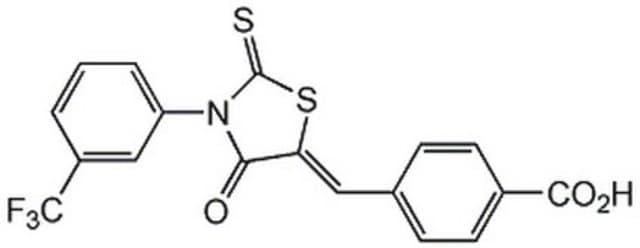219671
GlyH-101
≥97% (HPLC), solid, CFTR inhibitor, Calbiochem®
Synonim(y):
CFTR Inhibitor II, GlyH-101, N-(2-Naphthalenyl)-((3,5-dibromo-2,4-dihydroxyphenyl)methylene)glycine hydrazide
About This Item
Polecane produkty
product name
CFTR Inhibitor II, GlyH-101, CFTR Inhibitor II, GlyH-101, CAS 328541-79-3, is a cell-permeable potent, selective and reversible open-channel blocker of CFTR (Ki = 4.3 µM in CFTR-expressing FRT cells).
Poziom jakości
Próba
≥97% (HPLC)
Postać
solid
producent / nazwa handlowa
Calbiochem®
warunki przechowywania
OK to freeze
kolor
yellow
rozpuszczalność
DMSO: 200 mg/mL
Warunki transportu
ambient
temp. przechowywania
2-8°C
InChI
1S/C19H15Br2N3O3/c20-15-8-13(18(26)17(21)19(15)27)9-23-24-16(25)10-22-14-6-5-11-3-1-2-4-12(11)7-14/h1-9,22,26-27H,10H2,(H,24,25)/b23-9+
Klucz InChI
RMBDLOATEPYBSI-NUGSKGIGSA-N
Opis ogólny
Działania biochem./fizjol.
CFTR
Ostrzeżenie
Rekonstytucja
Inne uwagi
Muanprasat, C., et al. 2004. J. Gen. Physiol.124, 125.
Informacje prawne
Kod klasy składowania
11 - Combustible Solids
Klasa zagrożenia wodnego (WGK)
WGK 2
Temperatura zapłonu (°F)
Not applicable
Temperatura zapłonu (°C)
Not applicable
Certyfikaty analizy (CoA)
Poszukaj Certyfikaty analizy (CoA), wpisując numer partii/serii produktów. Numery serii i partii można znaleźć na etykiecie produktu po słowach „seria” lub „partia”.
Masz już ten produkt?
Dokumenty związane z niedawno zakupionymi produktami zostały zamieszczone w Bibliotece dokumentów.
Klienci oglądali również te produkty
Nasz zespół naukowców ma doświadczenie we wszystkich obszarach badań, w tym w naukach przyrodniczych, materiałoznawstwie, syntezie chemicznej, chromatografii, analityce i wielu innych dziedzinach.
Skontaktuj się z zespołem ds. pomocy technicznej









